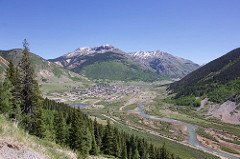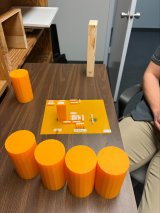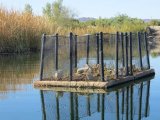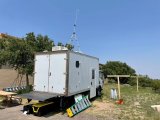EPA Research in Colorado

EPA researchers are working hard to protect communities across the nation. Learn about some of the work EPA researchers are doing in Colorado.
- Helping Community Drinking Water Systems Find Cost-Effective Solutions to Treatment Challenges
- Making Miniature Models to Track Air Pollution
- Response to Ricin Contamination
- EPA Uses Floating Vegetated Islands to Remove Excess Nutrients from Water
- Enhancing Local Readiness for Wildfires
- Real-Time Water Distribution System Analysis
- Custom-Designed Cleaner-Burning Stoves in Navajo Homes
- Innovative Method for Locating Fugitive Emissions
- Reducing Nitrogen at the Institutional Level
- Emissions Measurement Methods
- Heavy Metal Contamination from Abandoned Mines
- Metals Loading to Surface Waters
- Performance Evaluation of Popular Air Sensors
For more EPA work, see EPA in Colorado.
Helping Community Drinking Water Systems Find Cost-Effective Solutions to Treatment Challenges
Emerging contaminants, such as per- and polyfluoroalkyl substances (PFAS), are challenging to drinking water systems across the country. Effective treatment for emerging contaminants can be unknown, difficult, and extremely costly. Working with the state of Colorado, EPA researchers are providing technical assistance to a small community water system with PFAS concerns to help them identify optimal, cost-effective treatment methods and optimize the long-term operation of their chosen technology. These efforts will also be used to develop best practices and performance and cost estimate tools so water utilities across the country can make informed treatment and operational choices.
Making Miniature Models to Track Air Pollution

At the Office of Research and Development's (ORD) meteorological wind tunnel facility in North Carolina, researchers use scaled models to simulate the spread of harmful airborne material released in urban and industrial settings. For 50 years, EPA researchers have studied air flow and dispersion in this unique lab, using scaled models to simulate the spread of harmful airborne material released in urban and industrial settings. One project at the Wind Tunnel mimics an oil and gas facility outside of Denver. Learn more about this important work in Science Matters.
Response to Ricin Contamination
Ricin is a deadly biological toxin that is easily produced from castor beans, making it one of the most worrisome biological threat agents. In response to an increase in ricin incidents occurring between 2013-2019, including an incident in Colorado, EPA researchers in ORD developed innovative solutions that led to significantly shortened response times and decreased costs and resources required for ricin incidents. This work provided the federal government with important new capabilities for helping states and local communities respond to ricin incidents.
EPA Uses Floating Vegetated Islands to Remove Excess Nutrients from Water

Harmful algal blooms—the overgrowth of algae in water—are a major problem across the nation. They can cause severe, negative impacts on aquatic ecosystems, the economy, and human health. ORD worked with Chemehuevi and Colorado River Indian Tribes to evaluate the effectiveness of using man-made floating vegetated islands to reduce the occurrences of these blooms in water within the tribes’ reservations. Read EPA Uses Floating Vegetated Islands to Remove Excess Nutrients from Water.
Enhancing Local Readiness for Wildfires
Wildfire smoke continues to impact the health of many people in fire-prone areas in the United States. EPA and the U.S. Forest Service worked with two communities — including Garfield County, Colorado — that are increasingly impacted by wildfires to create smoke response plans. The results can be used by other health professionals to assist communities with developing their own smoke-ready plans. Read Partners Collaborate in Smoke-Ready Communities Research to Enhance Local Readiness for Wildfires.
Real-Time Water Distribution System Analysis
EPA's tool EPANET-RTX gives water utilities the necessary tools to enhance system operations including emergency response and improved operations, e.g., better pressure management, leak detection and water quality. EPANET-RTX has been tested or demonstrated in several locations including Ohio, Colorado, Florida, Kentucky, and Michigan.
Custom-Designed Cleaner-Burning Stoves in Navajo Homes
More than 60% of Navajo households use wood stoves for heat. The stoves are often very old, inefficient, and poorly vented, leading to high levels of indoor and outdoor air pollution and increased risk of fires. To combat these issues, ORD and collaborators have researched and designed a comprehensive stove replacement and home weatherization program that meets the needs of the Navajo Nation. Read EPA and Partners Bring Custom-Designed Cleaner-Burning Stoves to Navajo Homes.
Innovative Method for Locating Fugitive Emissions

Fugitive emissions, or pollution that escapes through unanticipated leaks, industrial processes, and other means, are difficult for scientists to measure and model. EPA scientists are collaborating with National Park Service and New Mexico Environment Department, as well as Colorado State University, to detect fugitive emissions using a portable, solar-powered air sampling system that can be remotely operated by text message. This regional research effort will help local regulators quantify and identify fugitive air pollution emission sources. Read Remotely Operated Air Samplers Offer an Innovative Method for Locating Fugitive Emissions.
Reducing Nitrogen at the Institutional Level
You’ve heard of a carbon footprint, but what about a nitrogen footprint? Nitrogen pollution can negatively affect air and water quality, as well as public health. EPA and collaborators, including Colorado State University, used the Nitrogen Footprint Tool to calculate the nitrogen footprint of seven universities and laboratories to see where they could reduce their nitrogen outputs. The results can help institutions develop better sustainability strategies for their campuses. Read Nitrogen Footprint Tool: Reducing Nitrogen at the Institutional Level.
Emissions Measurement Methods
Oil and natural gas production have increased significantly within Utah’s Uinta Basin, Colorado’s Denver-Julesburg Basin, West Virginia’s Marcellus Shale, and across the United States over the last decades. Oil and natural gas extraction and production activities co-emit volatile organic compounds, and greenhouse gases directly to the atmosphere. ORD, in collaboration with Region 8, is working with Utah and Colorado state officials and oil and gas operators to conduct emissions research on pneumatic controllers used in upstream production. The collaboration will ultimately support better development of US energy assets in ways that also protect human health and the environment.
Heavy Metal Contamination from Abandoned Mines

Many Tribal communities are impacted by mine wastes and heavy metal contamination from abandoned mines. There is community concern about how these contaminants impact human health and cultural practices. To help address these challenges, the EPA and NIH jointly funded the Center for Native American Environmental Health Equity Research from 2016 to 2021. The Center’s research results informed the work on exposure assessments to metals from private drinking water conducted among communities in Arizona, Colorado, New Mexico and Utah.
Metals Loading to Surface Waters

More than 500,000 abandoned mines found in the U.S. present risks to surface water, groundwater, and human and ecological health due to the volume and toxic nature of the waste produced at these sites. ORD, in collaboration with EPA Region 8, and with help from other partners, deployed a dense network of sensors that provide accurate water quality measurements on a continual basis. Colorado Department of Public Health and Environment, other state partners and remedial project managers were able to share results of specific sites, lessons learned, and provide additional support using these technologies. Best practices were captured and shared with key partners to improve strategies and lower costs associated with these mitigation efforts.
Performance Evaluation of Popular Air Sensors
There is wide interest from air monitoring agencies, researchers, and community groups in deploying smaller, more portable air sensor technologies for community-scale air monitoring projects. First, air sensors need to be thoroughly evaluated in order to understand their limitations and data quality. EPA partnered with six air monitoring agencies, including Colorado Department of Public Health and Environment, to operate five air sensor types alongside standard regulatory monitors so that data could be compared.
